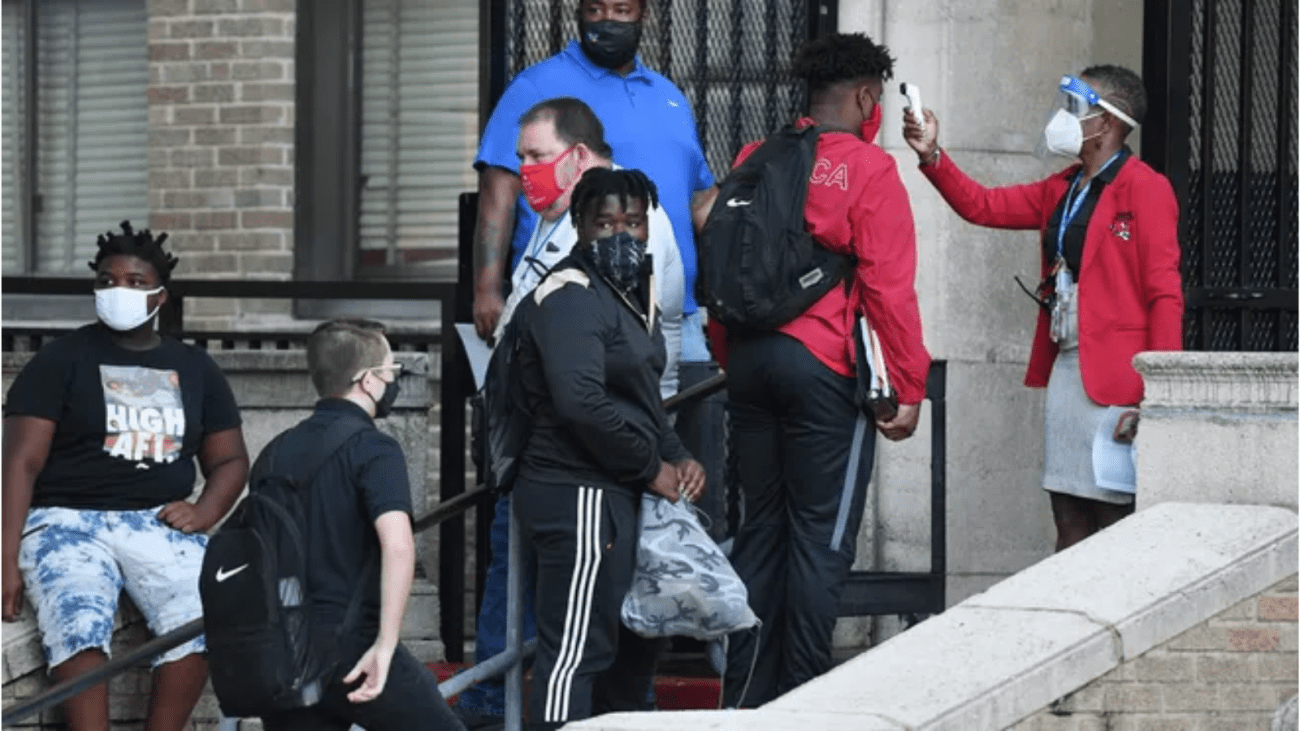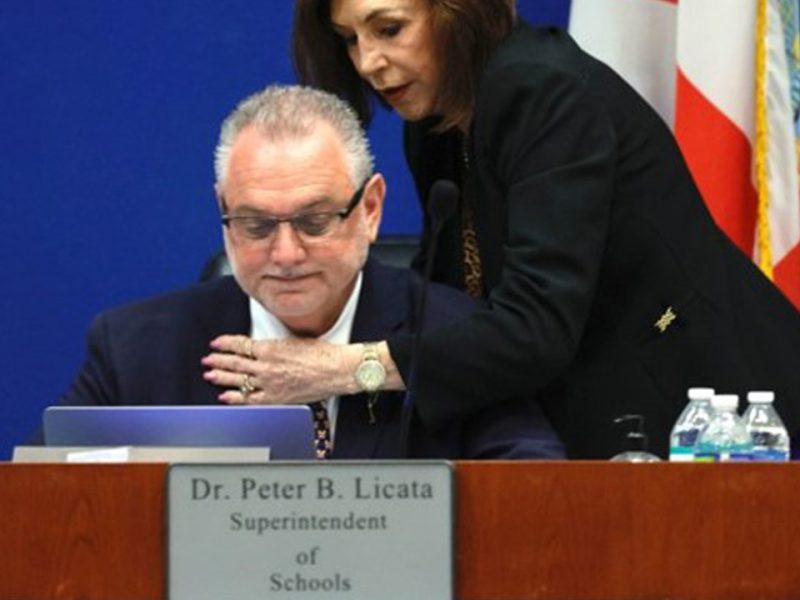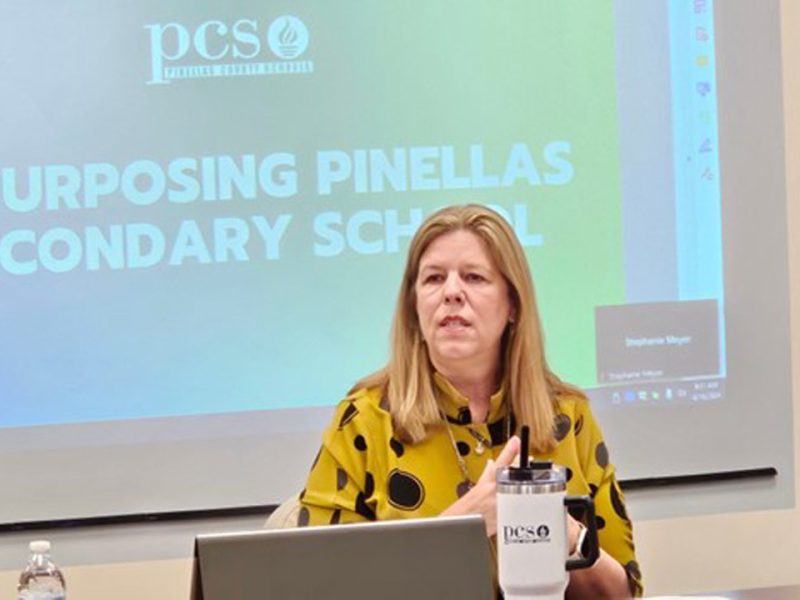Opportunity gaps closing, but Duval public school inequities underscore 904WARD report
Florida Times-Union | by Emily Bloch | March 23, 2021
Caran Mullins remembers the first moment she confronted her own racial biases and how they affected her perception.
Mullins is a white teacher who has worked in Title I schools for the last five years.
“When I was a first-year teacher in Alachua County, I taught 19 African American students. One of these students had outbursts occasionally, despite being an otherwise hard-working student. He used to say ‘What’s the big idea?’ in a silly, loud voice, all the time in class,” Mullins said.
Her first thought was that it was “street slang” used by adult males in his community, she said. She thought it was disrespectful. Her mind went to thinking about him growing up around people selling drugs. She silently judged him.
“If someone would have told me that I had biases toward African Americans, I would have been horrified. Yet, I did and what I believed about this child meant that I didn’t see him for who he was, but for all the things I thought he wasn’t … Many of these kinds of images from my past teaching haunt me.”
A couple of years later, the TV was on. Mullins heard the phrase she formed so much implicit bias around from her screen: “What’s the big idea?” It was Donald Duck.
“I looked over and to my dismay, it was ‘Mickey Mouse Clubhouse.’ At that point, I realized that the boy was quoting a child’s TV show and not street slang of a drug dealer. He was a child, being a child, and I made him into a lost cause in my head.”
Experts say issues like this, surrounding bias and equity, impact student performance.
Report shows there’s work to be done in Jacksonville schools
Over the years, the gap in graduation rates between Black and white students has narrowed in Jacksonville. But people like Kimberly Allen, CEO of 904WARD, say there’s still a lot of work to be done.
In Duval County, a new report by 904WARD shows that just over 50 percent of children are ready for Kindergarten when they enter and that an overwhelming majority (63.3 percent) of Black students in 3rd grade did not pass the state Language Arts baseline exam (Florida Statewide Assessments known as FSA testing) in the 2018-2019 school year.

A chart with Duval County Public Schools data shows that Black third grade students underperformed in the state Language Arts exam. 904WARD
The local volunteer organization, 904WARD, released its study about local disparity and opportunity gap failures among students of color last month. And while it’s noted that the opportunity gap is closing, the group says there is still more than 20-years worth of data demonstrating Black and brown students performing at or below grade level.
The report is the second of an eight-part series looking back at decades of local disparities and failed efforts to address them. This one focused on education. Others will focus on topics including health, housing, employment and politics.
Issues highlighted in the report include low testing and reading performance among Black students, a lingering gap between Black and white student performance despite Black and Hispanic students performing at the top of the national scale in reading and math and lower school grades or more variability among schools with higher minority populations.
“As our school district works through a new strategic plan with its newly-elected school board and recently-named Superintendent of the Year, there is explicit acknowledgment of the need to address literacy and the disparate school grades,” the report’s conclusion said. “To accomplish these goals, there must be serious emphasis on changing the outcomes for Students of Color since they make up the majority of the school district.”
Duval County Public Schools spokesman Tracy Pierce said the report highlights the relevance of the district’s new goals and strategic plan — a document that outlines the concrete priorities, values, and goals that will guide the district for the next several years that the district has been developing with community input.
“Our new plan under discussion with the board focuses on literacy, moving all schools to a ‘C’ grade or higher, improving postsecondary readiness and soft skills of graduates, and developing high-performing career education programs,” Pierce said.
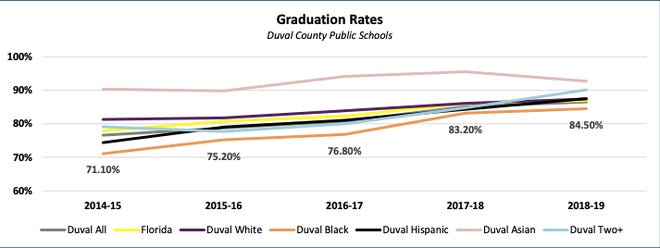
An infographic showing graduation rates among race in Duval County compared to the County and State average. 904WARD
Duval graduation rates above Florida average
This year, Duval County Public Schools continued a winning streak of record-high graduation rates, landing in the 90th percentile and placing higher than the state average.
Even with the caveats of COVID-19’s impact on the school year (and an anticipated dip in performance because of that skew for next year’s rates), the increase is a feat in the district’s view — marking a 26.9 percentage point increase over the last 10 years.
“The report recognizes the kind of success that is possible by highlighting what the district has achieved with the graduation rate and our students’ performance compared to peers of similar districts around the nation,” Pierce said. “Working together, our schools and our community have the capacity to achieve big goals.”
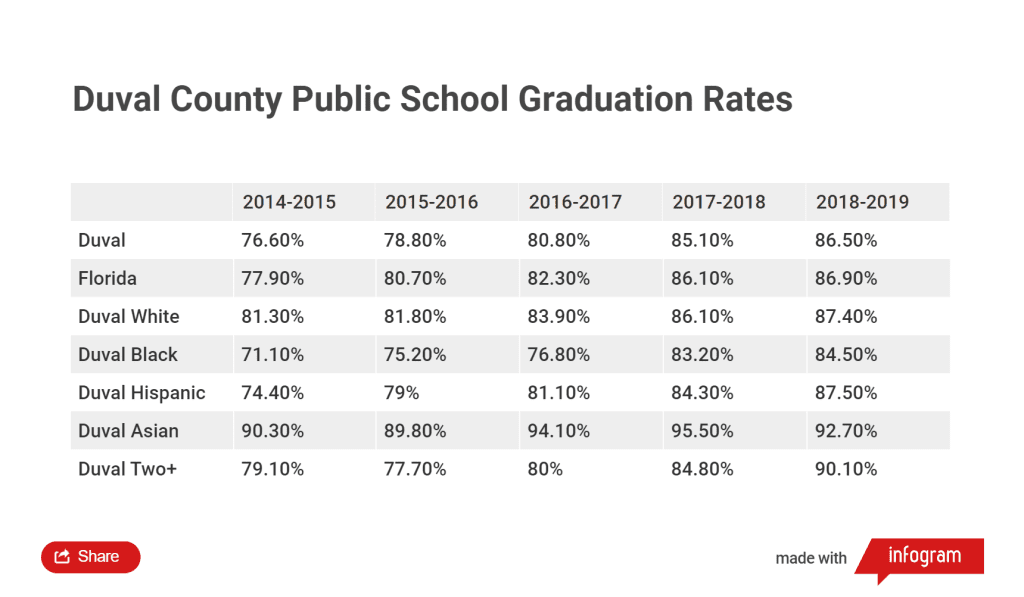
Internally, the school district has looked to teacher retention as a way to help calm historically rocky student performance.
It credits mentorship and professional development services that have rolled out in the last few years for helping to create some stability at schools.
Teacher turnover disproportionately affects low-income students of color and district data shows that lower school performance is linked to schools that have teachers with less experience.
Another more emotional element to it is that students tend to resonate better when they see a teacher that looks like them. Duval County Public Schools’ student body is 67 percent non-white, but its teacher makeup is only 40 percent non-white. Black male teachers make up less than 6 percent of the teacher workforce.
According to Elizabeth Krajewski of the Jacksonville Public Education Fund, exposure to a Black instructor decreases a student of color’s likelihood of dropping out. Additionally, she said that a student’s likelihood to develop implicit bias is also decreased when they are exposed to a diverse mix of educators.
“This is not only a Jacksonville issue, this happens in every single city you go to — you’ll see that disparity, especially with Black male teachers” School Board Vice-Chair Darryl Willie said at an event about teacher turnover and diversity. “There are systemic things that are happening that decrease the funnel. To make sure folks can actually end up in the classroom, you have to make sure enough Black male teachers are going into the funnel.”

The Duval Schools workforce is less diverse than the students body according to data compiled by the Jacksonville Public Education Fund. Jacksonville Public Education Fund
Allen with 904WARD said that now that the school district is seeing measurable improvements when it comes to graduation rates, the same gumption needs to be applied to other low-performance areas.
“We have to have that same energy around other academic areas where Black and brown students are not achieving at the same level as their counterparts,” Aleen said. “Why are the majority of Black and Latinx students not reading on grade level? How can we rally together again to support those students, family, teachers, administrators, schools and our education system to get better results for our students? Why are we seeing these results and, most importantly, how can we get better results?”
Education partners like the Jacksonville Public Education Fund are using 904WARD’s report as a compass when it comes to areas the group wants to work with the school district and other partners on improving.
“I’m grateful to 904WARD for shining a light on racial disparities in education,” the group’s president, Rachael Tutwiler Fortune, said. “We’ve seen so much progress over the last decade as educators and the community partnered to improve our graduation rate. We believe we can work together now to close the opportunity gap in Duval County.”
Stephanie Garry Garfunkel, the Jacksonville Public Education Fund Communications Director, said that the group’s key takeaways from 904WARD’s report include how inequities highlighted in the report stem from race and poverty issues.
“Some inequities stem from institutional racism and bias in schools,” Garfunkel said. “Inequities in schools are also a result of socioeconomic disparities in the community: race and poverty are linked because of historical inequities, with black students more likely to be living in poverty, which poses barriers to learning.”
Garfunkel added that the issues are cyclical — like an example she gave about poverty.
“About 28 percent of high school students in Duval have been exposed to multiple ‘adverse childhood experiences,” she said. Those can include traumas ranging from violence to food insecurity. “Brain science has shown us that trauma inhibits learning, but there are simple practices like nutrition and hydration, breathing exercises, teaching students to regulate their emotions, using restorative justice practices instead of punitive discipline that takes away learning time, etc. that can help them learn better.”
Partnerships help student performance
The education fund is partnering with the organization Hope Street Inc. to create a pilot trauma-informed practices training program for educators at Jacksonville Heights Elementary School. They hope to have results by the end of the school year.
Pierce says that partnerships — like with the education fund — are an integral piece to the puzzle when it comes to student performance and closing the opportunity gap.
“The leverage point for impact is at the school level, and many of the most challenged schools would benefit from engaged and supportive partners,” Pierce said. “If there are any businesses or community organizations that want to roll up their sleeves and jump into this work, please contact us so that we can plug you into a school that needs support.” (Pierce asked the Times-Union to include his email address in case readers want to reach out. It is piercet@duvalschools.org.)
Still, a lot of the work starts at the individual level.
These days in Duval County, Caran Mullins uses the example of her first teaching job and the student quoting Donald Duck as part of her motivation to do better.
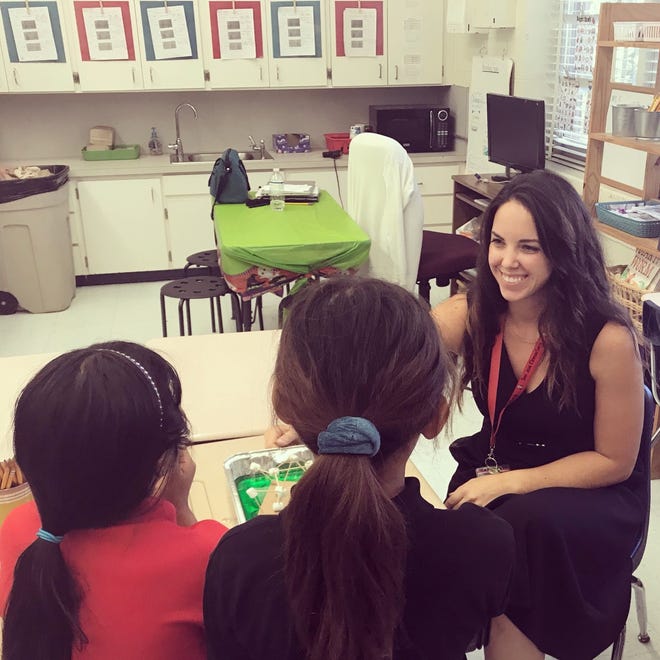
Caran Mullins with students at San Jose Elementary School. Courtesy Of the Jacksonville Public Education Fund
She studied racial equity in the classroom, reading books on the subject in her own time and participating in programs led by the University of North Florida’s Center for Urban Education and Policy as well as the Jacksonville Public Education Fund’s leadership initiative. She led a study group at San Jose Elementary School where she and her peers focus on equity. Now, she works at Seabreeze Elementary School, which she described as an opportunity to extend her conversations about equity.
Mullins is one of the Jacksonville Public Education Fund’s Cindy Edelman Excellence in Teaching fellows and she serves as a coach for the group’s Teacher Leading Initiative, working with other teachers on issues of race and bias in the classroom.
“Since beginning work in equity conscious practices, I have begun to see results regarding positive Black student outcomes in my class,” she said. “I no longer viewed these children through a deficit-lens. I have consciously began leading an anti-racist classroom where I seek daily to intentionally engage Black students in critical thinking, culturally responsive instruction, and relationship building opportunities.”
She added, “For myself, the success is in starting this work and continuing forward with action and purpose as a co-conspirator for racial justice and equity in not just our schools, but in our society.”
Featured image: Andrew Jackson Senior High School students have their temperature taken before they can enter the building on the first day of school Thursday, Aug. 20, 2020 in Jacksonville, Florida. [Bob Self/Florida Times-Union]



